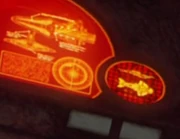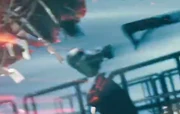Template:Realworld
Star Wars is a film and television franchise. From the very inception of Star Wars in 1977, there has been a definite rivalry between the Star Wars and Star Trek franchises, which Rod Roddenberry – son of Star Trek creator Gene Roddenberry, who is widely credited with creating Star Trek – learned of through first-hand experience, though Rod Roddenberry was a much bigger fan of Star Wars than Star Trek during his childhood. His father approved of Star Wars, considering it "fun" with "nothing wrong" about it. In 1986, he commented, "I like Star Wars. It was the young King Arthur growing up and... slaying the evil emperor, finally."
Before devising the origins of Star Wars, George Lucas attended a few Star Trek conventions. When interviewed by Rod Roddenberry in 2011, Lucas recalled, "I started writing Star Wars sort of in the heyday of the syndication part of Star Trek. I think the thing I was attracted to the most about Star Trek is that it completely got rid of all the mundane, boring angle of real space. And just said, 'Well, let's just go out and go where no one else dared to go' [....] Star Trek and Star Wars are not reality shows; they're imagination shows. The story is really the thing that makes it work." Lucas went on to point out that portraying the stories of both Star Wars and Star Trek was limited by resources such as the amount of budgets and technology available. Comparing Star Wars to Star Trek, he noted, "What I was doing was more space opera than sort of science fiction. Star Trek was more sort of intellectual mystery. It wasn't action oriented. Star Wars was action oriented." Lucas also acknowledged that both Star Wars and Star Trek have affected many millions of people. He doesn't put much stock in the fan-based competitiveness between Star Wars and Star Trek, remarking, "I couldn't even contemplate what would happen if you put the Enterprise up against the Millennium Falcon. You know, it's an intellectual exercise which, you know, could have any outcome you want." (Trek Nation)
Having become the most successful science fiction franchise in media history (see: Paramount Pictures: Footnote 7), the Hollywood studios United Artists and Universal Studios declined the opportunity to become part of it when they were approached by Lucas in the mid-1970s with the proposition for what was to become the first Star Wars movie installment of the same title. [1] The studio that had picked up the project, 20th Century Fox, refused to buy the marketing and licensing rights when Lucas needed additional funding to finish his movie. United Artists was ended after its 1980 disastrous western Heaven's Gate; Universal Studios did ultimately manage to produce the far less successful Star Wars-"inspired" science fiction franchise Battlestar Galactica of its own; and 20th Century Fox, aside from missing out on any and all takes from the huge Star Wars merchandise sales, is now completely out of the loop after the sale of Lucasfilm to The Walt Disney Company in 2012. Incidentally, adjusted for inflation the first Star Wars movie has become the all-time most grossing movie in history, only surpassed by the 1939 movie Gone with he Wind. It has been joined by all the others, including the seventh one, in the top-200, whereas none of the Star Trek ones have made the list. [2]
Star Trek in Star Wars

The Keldon class starship
In Star Wars: The Clone Wars Season 1 Episode 2 "Rising Malevolence" from 2008, at time index 02:37 a Keldon-class ship can be seen on a tactical monitor behind General Grievous.
During development on Star Wars Episode IV: A New Hope, George Lucas took inspiration from Star Trek, recalling that, like Lucas himself, Gene Roddenberry initially hadn't been entirely comfortable with developing a series and refining or pulling together the vision of a fictional world. (The Making of Star Wars: The Definitive Story Behind the Original Film, pp. 245-246)
Star Wars in Star Trek
Millennium Falcon cameo in Star Trek: First Contact

R2-D2's cameo in Star Trek

R2-D2's cameo in Star Trek Into Darkness
A scene in DS9: "Valiant", involving the USS Valiant battling a Jem'Hadar battleship, was intended to be evocative of the Battle of Yavin in Star Wars Episode IV: A New Hope. "That whole sequence, that technical thing that they found, it's all a deliberate homage to Star Wars," said Ronald D. Moore. (Cinefantastique, Vol. 30, No. 9/10, p. 61)
- Alderaan
- ISS Avenger
- Bothans
- Kashyk (see Kashyyyk)
- Millennium Falcon
- Nar Shaddan
- Quarren
- Skywalker Division
- Vader
- Duranium
- On close inspection, the drug dispensers that Q and his fellow soldiers from World War III wear as part of their uniforms are labeled "Army R2D3PO-D", a reference to the droids R2-D2 and C-3PO. [3]
Some aspects of Star Trek were deliberately not meant to have a Star Wars style. For instance, Makeup Supervisor Michael Westmore once described the background aliens in Star Trek: Deep Space Nine as being "basically within Gene Roddenberry's realm of not going into a Star Wars-type of creature." (The Official Star Trek: Deep Space Nine Magazine, Vol. 1, p. 28)
Crossovers
- Performers:
- Ian Abercrombie
- Ed Begley, Jr.
- David Birney
- Clancy Brown
- George Coe
- Olivia d'Abo
- Greg Ellis
- Fionnula Flanagan
- Cully Fredricksen
- Brian George
- Patty Maloney
- Mike Massa
- Simon Pegg
- Ron Perlman
- Brock Peters
- Ethan Phillips
- Deep Roy
- Clive Revill
- Raphael Sbarge
- Felix Silla
- Brent Spiner
- Daniel Stevens
- Carel Struycken
- George Takei
- Valerie Wildman
- Jason Wingreen
- Sam Witwer
- Greg Grunberg
- Michael Giacchino
- Production:
- J.J. Abrams, director, writer, executive producer
- Philip Barberio, special effects
- Maryann Brandon, film editor
- Bryan Burk, producer
- Ben Burtt, sound designer/sound mixer
- Ryan Church, conceptual artist
- John Dykstra, special effects
- Judy Elkins, sculptor
- Tommy Gormley, co-producer, first assistant director
- Barbara Hambly, writer
- Tommy Harper, executive producer
- Nilo Rodis-Jamero, conceptual artist, costume designer
- Michael Kaplan, costume designer
- Kevin Kiner, composer
- John Knoll, visual effects artist, visual effects supervisor
- John Paul Lona, illustrator
- Mary Jo Markey, film editor
- Ralph McQuarrie, model designer
- Daniel Mindel, cinematographer
- Andy Nelson, sound designer
- Michelle Rejwan, co-producer
- Ben Rosenblatt, co-producer
- Jessica F. Sherman, casting associate
- April Webster, casting director
- Alyssa Weisberg, casting director
Industrial Light & Magic
Industrial Light & Magic (ILM), a visual effects (VFX) and animation company, was formed in 1975 as part of Lucasfilm Ltd. for the express purpose of realizing the optical and miniature effects for the first Star Wars film, continuing to do so for all the subsequent ones. The company has contributed work to eight of the twelve Star Trek films in addition to "Encounter at Farpoint". Many of ILM's VFX staffers have worked on both franchises.
- For further information: See main article
External links
- StarWars.com - official site
- Star Wars at Wikipedia
- Wookieepedia - Star Wars wiki
